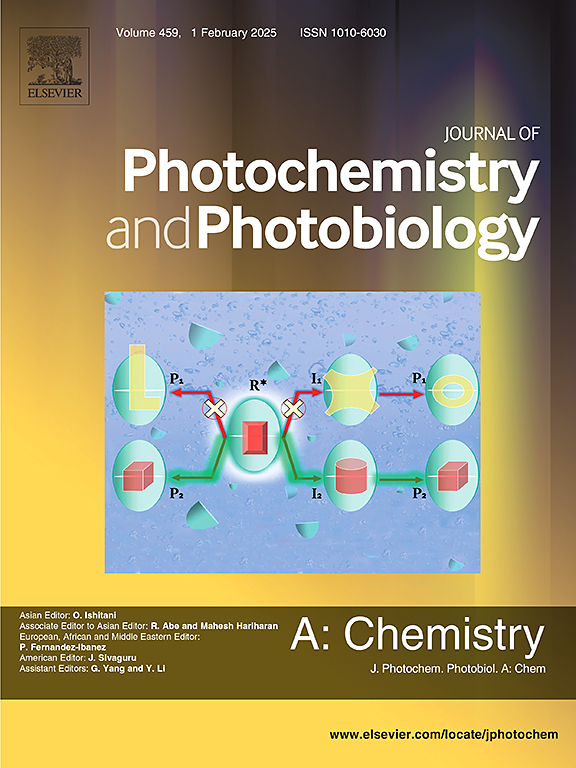Improving the efficiency of ultraviolet-C light-emitting diode water disinfection reactors by using light guide plates
IF 4.1
3区 化学
Q2 CHEMISTRY, PHYSICAL
Journal of Photochemistry and Photobiology A-chemistry
Pub Date : 2025-06-28
DOI:10.1016/j.jphotochem.2025.116601
引用次数: 0
Abstract
Light guide plates have been widely used to convert light-emitting diode (LED) point light sources into uniform surface light sources for lighting and backlighting applications. Because of their unique optical features, light guide plates can be used to achieve uniform ultraviolet light irradiation of microbes in water and to improve the performance of reactors equipped with ultraviolet-C LEDs. This study examined the effects of LED arrangement and microstructural pattern on irradiance uniformity and on Escherichia coli inactivation effectiveness. Four LGP configurations (single-side emission with uniform microstructures (SU), single-side emission with gradient microstructures (SG), double-side emission with uniform microstructures (DU) and double-side emission with symmetric microstructures (DS)) were designed in this study to improve irradiance uniformity. Simulations and experiments were conducted to determine the ultraviolet fluence received by microbes and the inactivation value of E. coli. The simulation results indicated that the DS configuration had the highest irradiance uniformity value of 85.7 %, which was approximately 62.3 %, 38.1 %, and 22.7 % higher than the values of the SU, DU, and SG configurations, respectively. Similarly, the experimental results indicated that the DS configuration had the highest inactivation value of 5.1 log at a flow rate of 300 mL/min, which was 19.0 %, 13.4 %, and 10.4 % higher than the values of the SU, DU, and SG configurations, respectively. In summary, this study developed a novel light guide plate configuration that can improve the efficiency of ultraviolet-C LED water disinfection reactors.
利用导光板提高uv - c发光二极管水消毒反应器的效率
导光板已被广泛用于将发光二极管(LED)点光源转换为均匀的表面光源,用于照明和背光应用。由于其独特的光学特性,导光板可用于实现水中微生物的均匀紫外光照射,并可提高配备uv - c led的反应器的性能。本研究考察了LED的排列和微结构模式对辐照均匀性和大肠杆菌灭活效果的影响。为了提高辐照均匀性,本研究设计了4种LGP结构(单面均匀发射(SU)、单面梯度发射(SG)、双面均匀发射(DU)和双面对称发射(DS))。通过模拟和实验确定了微生物接受的紫外线辐照量和大肠杆菌的失活值。模拟结果表明,DS配置的辐照度均匀度值最高,为85.7%,分别比SU、DU和SG配置高62.3%、38.1%和22.7%。同样,实验结果表明,在300 mL/min流速下,DS组的失活值最高,为5.1 log,分别比SU、DU和SG组的失活值高19.0%、13.4%和10.4%。综上所述,本研究开发了一种新的导光板配置,可以提高紫外- c LED水消毒反应器的效率。
本文章由计算机程序翻译,如有差异,请以英文原文为准。
求助全文
约1分钟内获得全文
求助全文
来源期刊
CiteScore
7.90
自引率
7.00%
发文量
580
审稿时长
48 days
期刊介绍:
JPPA publishes the results of fundamental studies on all aspects of chemical phenomena induced by interactions between light and molecules/matter of all kinds.
All systems capable of being described at the molecular or integrated multimolecular level are appropriate for the journal. This includes all molecular chemical species as well as biomolecular, supramolecular, polymer and other macromolecular systems, as well as solid state photochemistry. In addition, the journal publishes studies of semiconductor and other photoactive organic and inorganic materials, photocatalysis (organic, inorganic, supramolecular and superconductor).
The scope includes condensed and gas phase photochemistry, as well as synchrotron radiation chemistry. A broad range of processes and techniques in photochemistry are covered such as light induced energy, electron and proton transfer; nonlinear photochemical behavior; mechanistic investigation of photochemical reactions and identification of the products of photochemical reactions; quantum yield determinations and measurements of rate constants for primary and secondary photochemical processes; steady-state and time-resolved emission, ultrafast spectroscopic methods, single molecule spectroscopy, time resolved X-ray diffraction, luminescence microscopy, and scattering spectroscopy applied to photochemistry. Papers in emerging and applied areas such as luminescent sensors, electroluminescence, solar energy conversion, atmospheric photochemistry, environmental remediation, and related photocatalytic chemistry are also welcome.

 求助内容:
求助内容: 应助结果提醒方式:
应助结果提醒方式:


